Look beyond the horizon: orbital reconnaissance and strike echelon
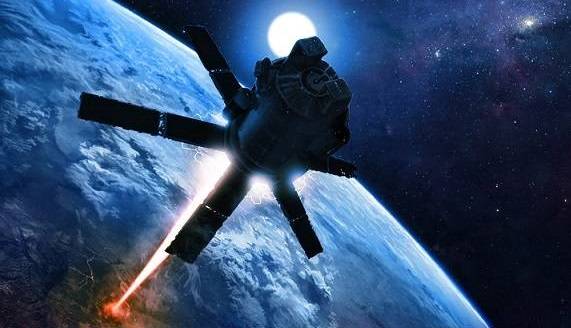
The strategy and tactics of warfare have always been determined by technology. Perhaps this was most clearly manifested when the bow and arrows appeared - weapon, allowing a weak opponent to defeat a much stronger one. Further story developed with acceleration - guns and guns, rifles and machine guns, Tanks, artillery and aviation, drones and thermal imagers. Nuclear weapons stand apart, in some situations they are “absolute weapons”, and sometimes their presence does not matter at all.
But where are we going? How will weapons and wars change, for example, at the turn of 2050-2100?
Technology is developing so rapidly that it is extremely difficult to answer this question. Could someone predict, for example, in 1980, such a widespread development of digital communication networks? The widest saturation of the battlefield with civilian unmanned aerial vehicles (UAVs), which have a much stronger impact on the battlefield than high-tech hypersonic or laser weapons? On the other hand, who could have predicted the months-long "standing" of the Russian and Ukrainian troops, reminiscent of the battles of the First World War, when the same settlement does not leave the tapes for months News?
So what kind of weapons will humanity fight in half a century? Tanks weighing 150 tons with guns of 240 mm caliber or kamikaze UAVs the size of a fingernail?
Let's try to consider possible directions for the development of the armed forces at the turn of 2050-2100, taking into account those technologies that have already appeared or whose appearance can be expected in the foreseeable future. And we will start with outer space, since it is the ability to conduct combat operations in space / from space that will most likely determine the status of a “great power” in the XNUMXst century. The volume of the article does not allow to reveal the topic in detail, so a number of points will be voiced thesis.
Prices and technologies
In the middle of the XNUMXth century, the great powers were rushing into outer space. The first successes were so dizzying that it seemed that very soon humanity would rush to the stars, and the development of the solar system was taken for granted.
In reality, everything turned out to be much more complicated. The main problem of space exploration was the high cost of launching a payload (PN) into orbit, which could not be significantly reduced in the XNUMXth century, since each launch meant the inevitable loss of monstrously expensive disposable launch vehicles (LV). The emergence of reusable spacecraft (SC) Space Shuttle did not solve the problem, since the cost of the payload output did not decrease (rather, it even increased), plus resonant accidents with the death of American astronauts were added to this, which in no way contributed to the popularity of the Space Shuttle program, as well as the collapse USSR, as a result of which the United States imagined itself to be the masters of the planet and focused on fighting the opponents of Pax Americana throughout the planet.
Nevertheless, ways to reduce the cost of launching into orbit were found - the private company SpaceX, whose name alone causes indigestion for many, like the name of its founder Elon Musk, was able to create a partially reusable Falcon 9 launch vehicle and its version with increased payload Falcon Heavy. Their distinguishing feature is the reusable use of the most expensive first stage. The side boosters (for the Falcon Heavy) and the nose fairing can also be reused.
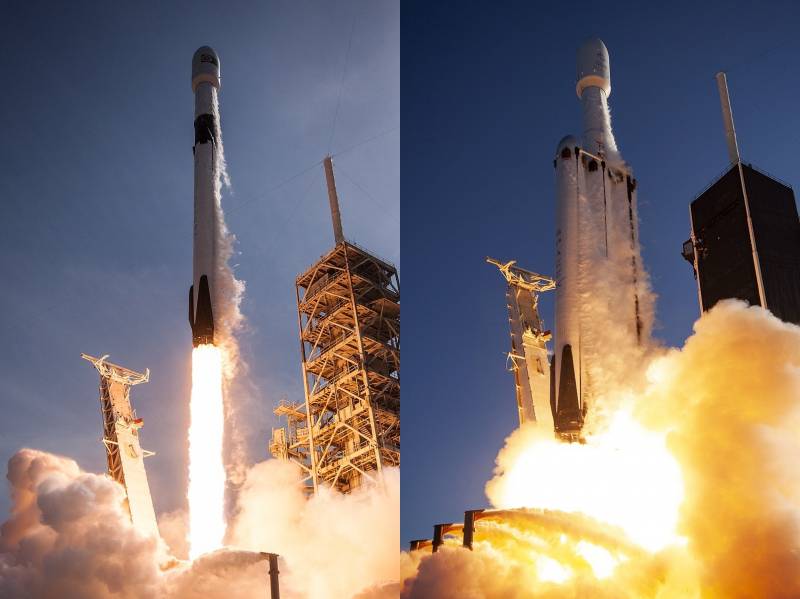
Falcon 9 launch vehicle (left) and Falcon Heavy launch vehicle (right) - and how many jingoistic articles were there that talked about the futility of creating a Falcon family launch vehicle - they say, their body is thin and high, and there are a lot of engines, and about the theft of Soviet technologies , and about many other things - a clear example of the harm of hatred
A little later, SpaceX developed the reusable Dragon spacecraft, which exists in cargo and passenger (Crew Dragon) versions.

Dragon reusable spacecraft
It is characteristic that, despite all the disagreements and the actual war between Russia and the United States on the territory of Ukraine, on March 1, 2023, the Russian-American crew went to the International Space Station precisely on the Crew Dragon spacecraft - such is international isolation.
Even the evolutionary development of the Falcon family of launch vehicles will give the United States huge advantages in deploying infrastructure in outer space, but SpaceX has a much more significant project on the way - a fully reusable two-stage stainless steel Starship / Super Heavy rocket system, whose first orbital flight is expected in 2023.
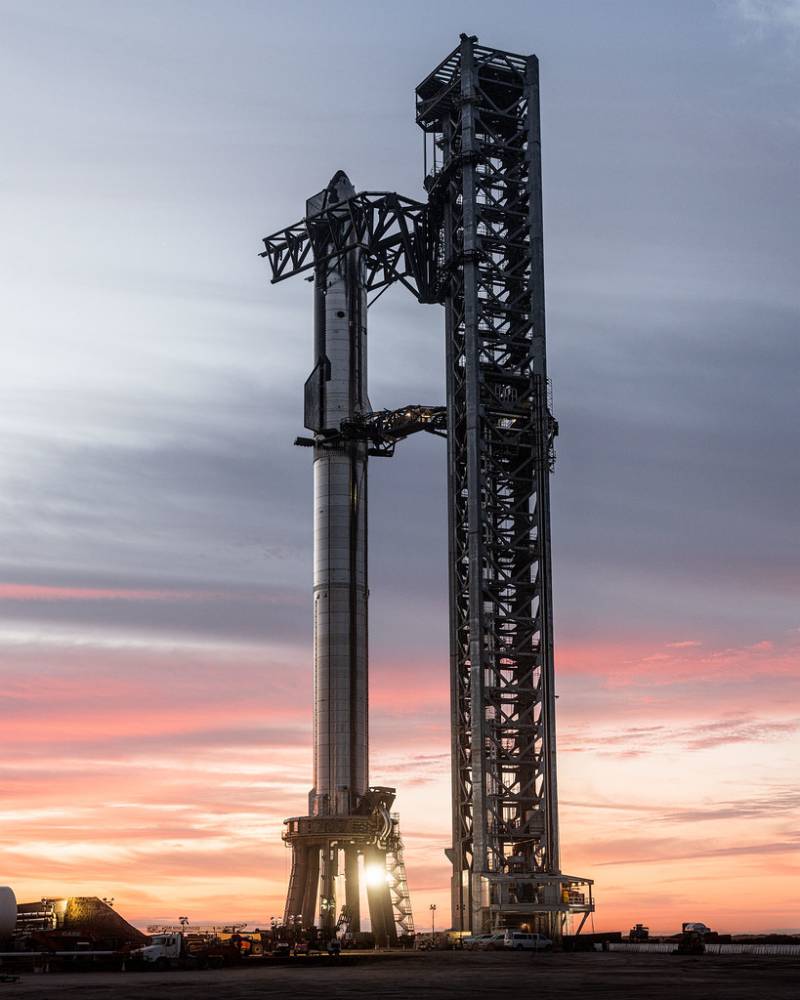
Starship/Super Heavy in starting position
According to preliminary calculations, Starship / Super Heavy will reduce the cost of launching a launch vehicle into low Earth orbit (LEO) to $100 per kilogram, which will be a real revolution in space exploration and will allow you to implement everything that we will talk about below.
A few years ago, the author had a double feeling - on the one hand, the United States has always been our competitor, almost an enemy, even though it was a cold war, so, it would seem, any of their failures should have pleased, but latently there was a desire that humanity was able to make a new breakthrough into space, which will force other countries to move in this direction, because space is the only thing that can lead the global economy out of the planetary impasse. But now, when the United States, and SpaceX as well, are waging a real war against our country, one can only hope that Starship / Super Heavy is just the top of the financial pyramid, and if not, then this rocket will crash upon takeoff, burying Underneath are American hopes for space superiority - let them fly on the SLS launch vehicle, they may go bankrupt ...
Touch segment
In principle, it can be built with the current level of development of the launch vehicle, in addition, it already exists and is being developed. The sensor segment is a collection of reconnaissance, control and communications satellites (RUS). They can be owned by the state or private companies, but if necessary, function as a single unit in the interests of the armed forces.
The most obvious example of the prospects for building a sensor segment in the near future is the Starlink communications satellites of the aforementioned SpaceX company, whose number in orbit exceeds the number of all artificial Earth satellites (AES) belonging to all countries of the world combined. More than 3 Starlink satellites have already been launched, and theoretically their number could reach 500. They provide not only communication with the surface, but also high-speed communication with each other (in the latest modifications via optical data lines).
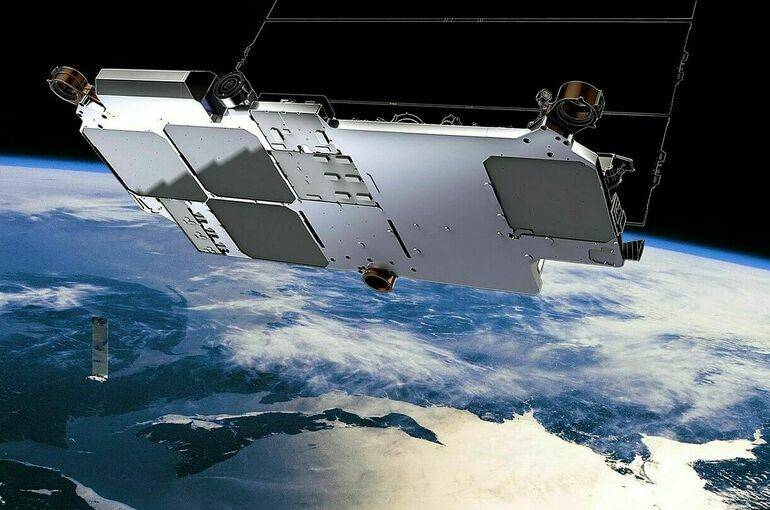
Starlink active phased array satellite - thousands of them
Potentially, Starlink satellites can be used as navigation satellites - while Elon Musk slowed down the development of this function in order to minimize costs. The possibility of using Starlink satellites for conducting electronic and even radar reconnaissance cannot be completely ruled out (so far this is hardly possible, but who knows what functionality future versions will receive).
Another example is radar satellites for remote sensing of the Earth of the commercial company Capella Space, capable of obtaining an image of the earth's surface in the radar wavelength range with a resolution of less than 50 centimeters.
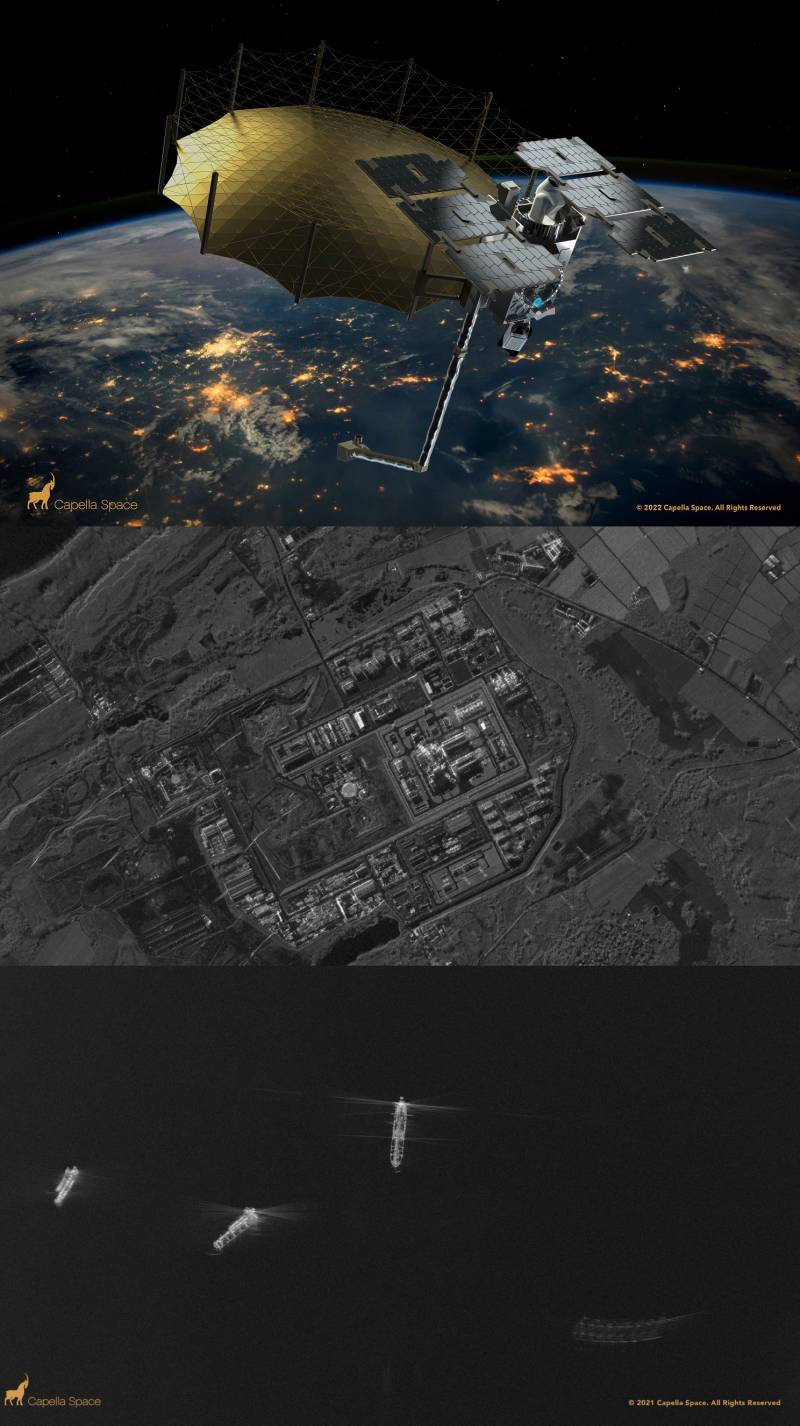
Capella Space Earth Remote Sensing Satellite and Images
In the short term, the number of RUS satellites in orbit will rapidly increase, as will their characteristics. The accuracy of determining the coordinates of objects on the surface will reach millimeter values. The resolution of images obtained in the optical and radar wavelength ranges will be measured in units of centimeters.
It can be assumed that by 2100, developed countries will be able to obtain images of almost the entire earth's surface, in several spectral ranges, with high resolution, in close to real time.
It is easy to imagine how this will affect the ability of the armed forces to fight. Already now in Ukraine, the Armed Forces of the Russian Federation (RF Armed Forces) are feeling the effectiveness of satellite reconnaissance assets of NATO countries, and in the future the situation will only get worse. This is especially true for those elements of the strategic nuclear forces (SNF) that rely on secrecy.
Moreover, not only ground, but also air targets will be detected, in particular, the US Air Force (Air Force) is already considering this possibility. Even taking into account all the possible risks, there is no doubt that in 50 years this task will certainly be solved.
The use of advanced sensors based, among other things, on the use of quantum effects will make it possible to obtain other information about events occurring not only on the surface, but also under water, and possibly underground. For example, highly sensitive sensors capable of detecting changes in the Earth's magnetic and gravitational fields will make it possible to detect large underwater objects, such as submarines, from space. Even now, in our time, China is working on the possibility of detecting submarines from space using laser radars - lidars.
Quantum computers and neural networks will be widely used to process huge amounts of data.
Of course, the receipt of intelligence data in almost real time will make it possible to provide guidance to the identified targets of weapons, without the use of ground / surface / air reconnaissance means. But this will be only the first stage in the formation of an orbital reconnaissance and strike echelon.
Space-to-surface segment
The next step will be the deployment of space-to-surface strike weapons. Such projects began to be developed at the beginning of the XNUMXst century (and maybe even earlier), for example, we can recall the American program Rods from God (“Wands of God”), and there is no doubt that now they will be brought to their logical conclusion. The main problem, most likely, was the cost of launching the PN into orbit, but now, as we said earlier, this problem will soon be solved.
When striking from space, gravity plays on the side of the attacker - in principle, even explosives may not be required. Massive refractory metal rods can be used to hit pinpoint, well-buried targets, while the power of a kinetic strike can be equivalent to entry-level tactical nuclear charges, and a “shower” of compact pins will be able to turn large ground objects into minced meat - military bases, ships, industrial facilities.
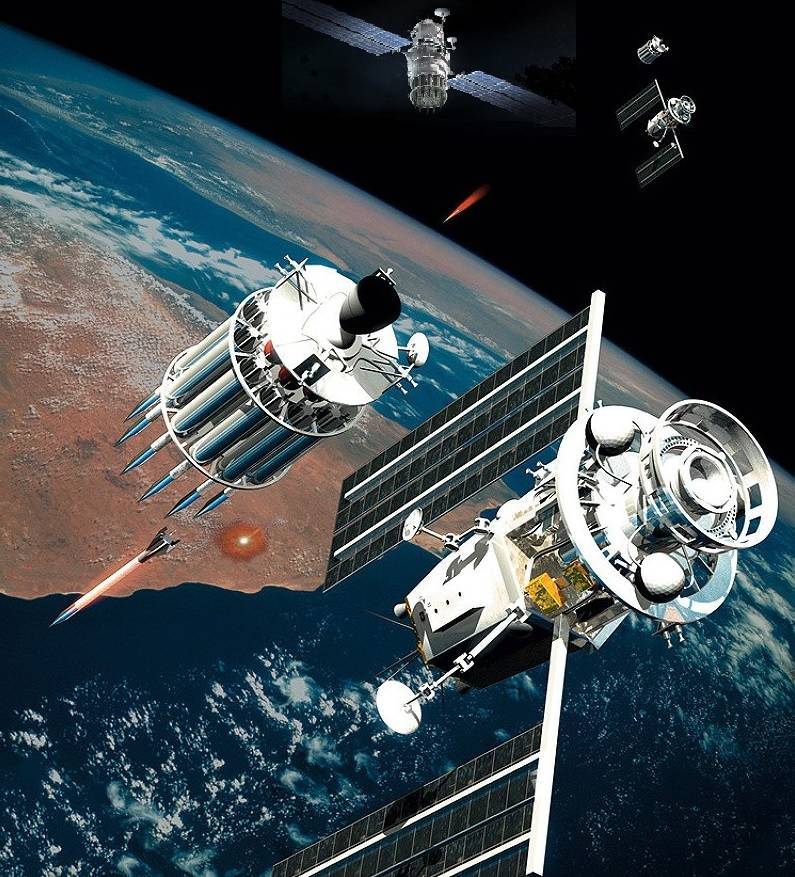
Rods from God
Separately, it is necessary to highlight the possibility of pinpoint destruction of ground targets from space with laser weapons. This is not about the destruction of tanks or ships, but about the defeat of the so-called "soft" targets - people.
In itself creating laser weapons for outer space is far from a trivial task - the problem is the low efficiency of existing lasers and the difficulty in removing heat from them in a vacuum. However, long-term operation of lasers is not required to destroy single point targets. Thus, laser weapons in space can become a terrible weapon of VIP terror, designed to defeat any people objectionable to its owner - the leaders of unfriendly countries hiding in other countries of political refugees.
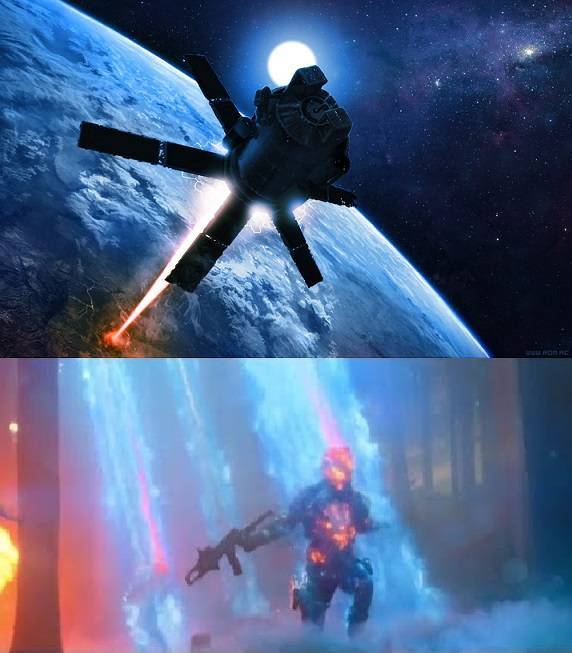
"Angelfire" - footage from the series "Altered Carbon"
It will be a very scary world for those who cannot withstand the enemy's orbital strike systems - the ability to turn into a charred corpse at any moment will force potential targets to hide underground, but even there they will not be completely protected from a strike from space by kinetic weapons, unless they will fall the likelihood of their discovery.
Can space-to-surface weapons be counteracted from Earth? It is possible, but only on an extremely limited scale, since gravity will be on the side of the attacker - launching a payload in bulk will always be cheaper than launching surface-to-space missiles.
Segments "space-to-air" / "space-to-depth"
Space-to-air armament will most likely appear after space-to-surface orbital strike groups are deployed. Considering the high speed of movement and maneuverability of air targets, means of adjusting the attacking ammunition throughout the flight will be required.
At the final stage, for example, the warhead can be undermined at a height of several hundred meters above the target, turning into a cloud of ready-made striking elements - refractory pellets covering an area of several hundred square meters. Or the space-to-surface orbital munition will be a descent vehicle, intensively braking at a given altitude, and releasing several modified air-to-air missiles with an active radar (or even multispectral) homing head and a feedback channel for target designation from satellites.
The most difficult task will potentially be the realization of the possibility of destroying submarines from space - now this may seem like unscientific fiction, but, on the other hand, if the detection of submarines with LEO becomes a reality, then the issue of their destruction may well be considered, according to at least when the submarine is at a shallow depth. Do not forget that we are considering a time period of over 75 years.
Space-to-space segment
Of course, the emergence of orbital strike systems will also lead to the emergence of space-to-space weapons. In fact, it appeared back in the XNUMXth century, and the Soviet Union was the leader in its creation. Even now, information periodically appears about Russian “inspector satellites” that bring a sense of alarm to the American military.
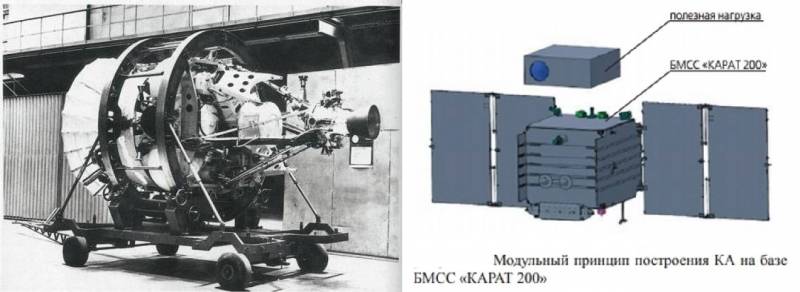
Serial anti-satellite system "IS-M" and the image of the alleged "satellite-inspector" based on the platform "Karat-200"
The United States, in turn, has its own secrets, for example, the X-37 unmanned orbital spaceplane, capable of being in orbit for years, maneuvering and carrying an unknown payload hidden inside it.
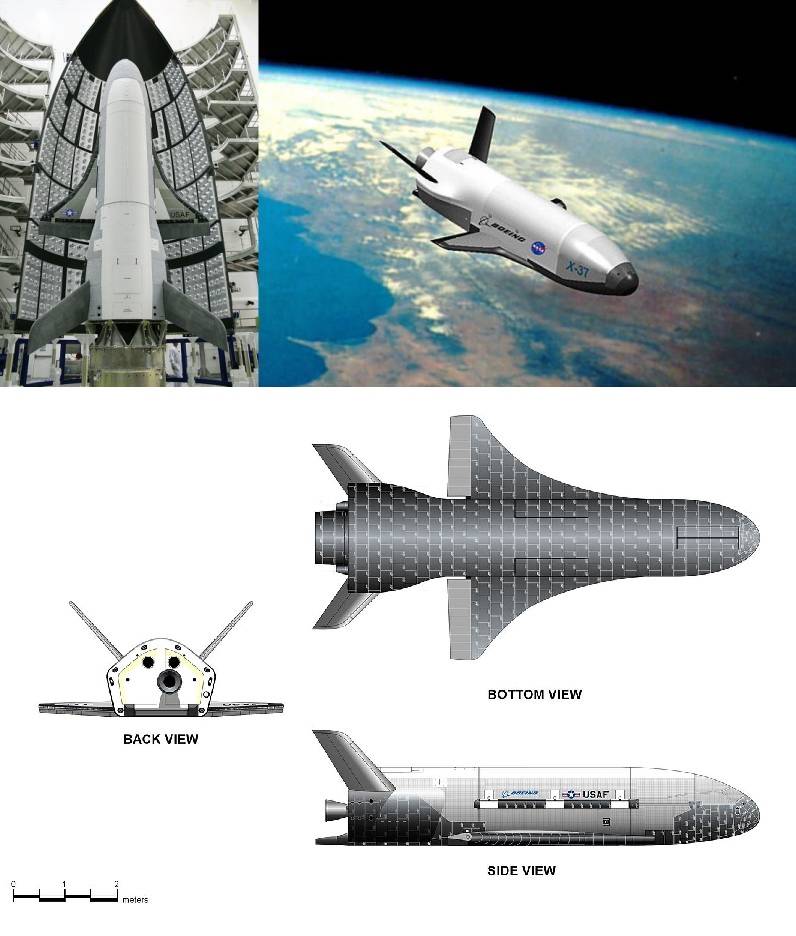
American reusable unmanned "shuttle" X-37
Also, the American private company Sierra Nevada Corporation is developing a reusable unmanned spaceplane Dream Chaser Cargo System. With the additional Shooting Star module, the Dream Chaser Cargo System spaceplane will be able to carry a payload of up to 7 tons and operate in orbits, up to highly elliptical and geosynchronous.
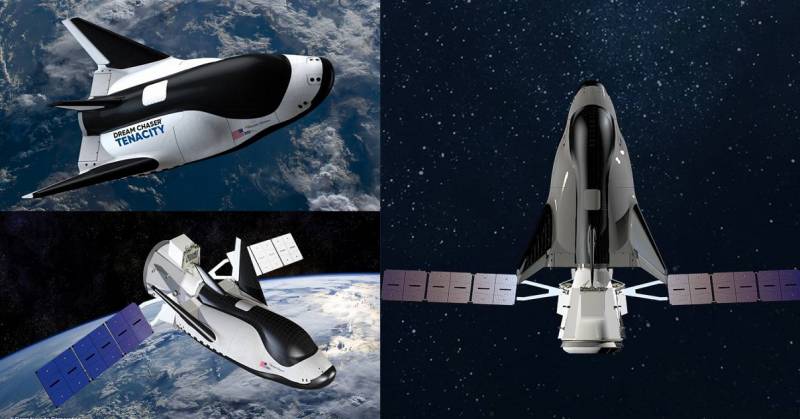
Dream Chaser Cargo System
Both of these machines may well be suitable for the role of orbital interceptors. However, all these complexes can work against enemy satellites, when there are dozens, a maximum of hundreds.
The problem is that in the future there will be thousands - tens of thousands of satellites for various purposes in orbit. Someone is counting on the use of nuclear weapons in space, but its effect will be very limited, and the low cost of putting a payload into orbit and large-scale production of satellites will allow the enemy to quickly make up for losses. Someone talks about the “bucket of nuts” and the Kessler effect, but there are no guarantees that it will really work until, perhaps, some of the satellites will be destroyed, but it is extremely doubtful that even LEO in the entire range, not to mention more high orbits.
It is possible that specialized spacecraft will appear - interceptors designed for the massive and relatively inexpensive destruction of hundreds of enemy satellites, for example, something like orbital interceptor "Reaper".
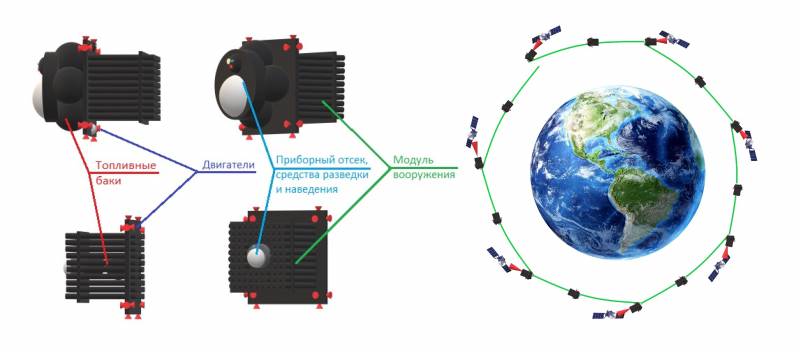
The concept of the orbital interceptor "Reaper"
PRO segment
Missile defense (ABM) is one of the most important tasks that will be provided by the corresponding segment of the orbital reconnaissance and strike echelon.
The United States has always made the greatest efforts in creating missile defense systems, hoping to gain a unilateral advantage over the USSR. They failed to complete with a positive result Star Wars program during the Cold War. The current US missile defense system is also not capable of containing a massive enemy strike launched with the help of intercontinental ballistic missiles (ICBMs). The emergence of an orbital missile defense segment could turn the tide and potentially intercept thousands of warheads.
Moreover, enemy warheads can be hit at all stages - in mines or on mobile carriers, with the help of space-to-surface kinetic orbital strike systems, at the climb stage, with the help of laser weapons and space-to-air destruction systems, as well as directly in outer space, using cluster interceptors.
Satellites equipped with highly sensitive infrared sensors capable of detecting the launch of ICBMs and tracking them, as well as providing tracking of hypersonic missiles, and other aircraft emitting a powerful infrared radiation flux at all stages of flight, are already being developed in the United States.
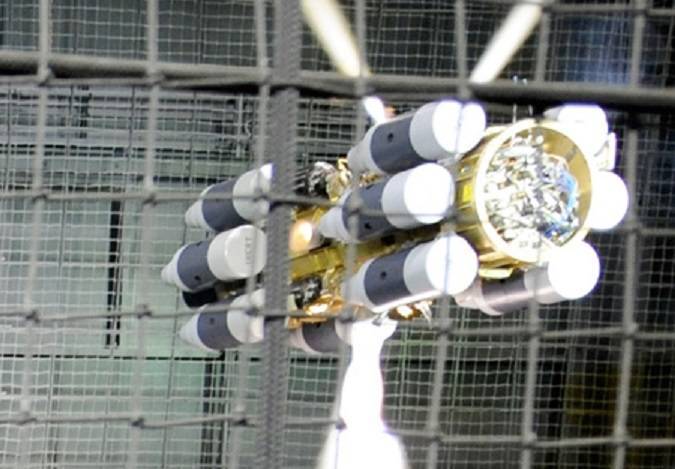
MKV Cluster Interceptor
Conclusions
The deployment of an orbital reconnaissance and strike echelon will radically change the format of confrontation on land, on water (under water) and in the air. Only those powers that can create powerful orbital clusters of satellites for various purposes will dominate the planet. Everyone else is assigned the role of "second-class" powers, whose fate is to obey the will of the winner. The most serious chances for the creation of orbital reconnaissance and strike echelons are in the United States, China and, for the time being, Russia.
The creation of orbital reconnaissance and strike systems will only be the beginning. The low cost of putting a payload into orbit will provoke the development of space technologies, including advanced engines and energy sources, most likely nuclear, on the basis of which spacecraft capable of operating in the depths of the solar system will be created.
Information